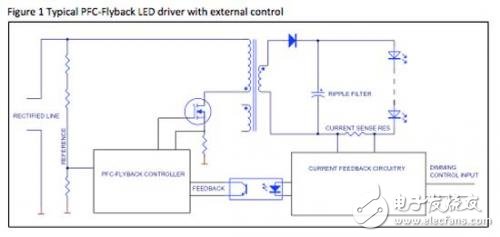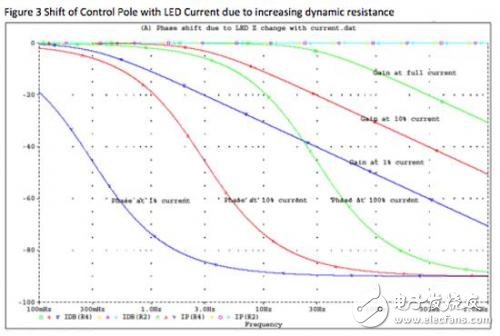The dimming LED driver will have light output stability problems at low light levels. This article will explore the root cause of this problem and propose a solution. The dimming technique of bidirectional thyristors is not discussed in this paper because low light quantity instability is caused by different mechanisms. The dimming method of setting the LED current using communication technology includes DALI, 0-10V, Zigbee, and power line carrier control. The LED driver receives a signal and uses it to set the reference current while the control loop adjusts the LED current to match the reference current. Only with high control accuracy can the brightness of adjacent fixtures be the same. The flicker and low light that occurs at low light levels is confusing for designers. Single stage power factor correction If a two-stage power converter is used, low light quantity instability occurs again. The first stage (boost or PFC-flyback) establishes a more stable voltage, and the second stage (usually a buck inverter) precisely regulates the current in the LED. Because of the need to use more components, the two-stage solution is not as energy efficient as a single-stage converter. For cost considerations, LED manufacturers typically use a single-stage PFC-flyback converter. problem The dimming should be provided in at least the interval of 20, and the incandescent lamp has no problem. At low optical power, the energy efficiency of the incandescent lamp is greatly reduced, and the power range required for the 20-light interval is relatively narrow. If 40% of the voltage or current is supplied, the light output will drop to approximately 1%. The market expects LEDs to solve this problem. The linear response of LEDs is much better than incandescent lamps, and at lower currents, the energy efficiency is higher. The human eye can discern the difference of 5% between adjacent light sources, only reacting to the degree of difference expressed as a percentage, and the absolute amount of light does not cause human eye reaction. This requires tight control of the current, and the control accuracy is higher at low light levels. If you need to adjust to 1% of full output, you cannot use primary side control. Unlike incandescent lamps, LEDs do not have a self-filtering mechanism. The heat capacity of an incandescent filament is a good AC filter, while an LED requires an external filter circuit. A common solution is to connect a large electrolytic capacitor directly to the LED, and the filtering effect is good. The capacity of the electrolytic capacitor is determined according to the requirements of the optical ripple. If the ripple current is less than 10% rms (approximately 28% pp), the human eye perceives the same light quality as pure DC. (Also, if the ripple current is above 10%, the ENERGY STAR logo requires a statement on the light.) The LED has a dynamic resistance (slope resistance) that is about 1/10 of the apparent V/I resistance. Figure 2 shows the VI curve of a typical LED. Therefore, if the ripple current is less than 10% RMS, the capacitor must control the voltage on the LED to within 1%. The required values ​​are: Unfortunately, the capacitor is also part of the control loop. The capacitor and LED dynamic resistance set the control loop pole to approximately 30 Hz. Therefore, at this frequency, the capacitance increases by a 45-degree phase lag, reducing the loop gain by 6 dB. We will discuss this issue later. The figure below details the gain and phase shift due to the polarity of the LED control loop. Note that the dynamic impedance of the LED increases as the current decreases. Unfortunately, this moves the control loop pole to the left. At 10% current, the corner frequency is approximately 3 Hz. At 1% current, the corner frequency is approximately 0.3 Hz. Note that for the PFC stage, a typical control loop has a crossover frequency of 3 Hz to 20 Hz. It is unreasonable to design a control loop with a pole that is movable within this range. The only viable solution is a crossover frequency design of 0.03 to 0.1 Hz, but the control loop will become very sluggish. Effect And Laser Light
Laser Light include 1w,2w,3w,5w,8w,10w and so on....
10W RGB Laser Projector Stage Animation Light 40Kpps ILDA Small Beam Full Color
Description:
1) suitable,high brightness
Our company have 13 years experience of LED Display and Stage Lights , our company mainly produce Indoor Rental LED Display, Outdoor Rental LED Display, Transparent LED Display,Indoor Fixed Indoor LED Display, Outdoor Fixed LED Display, Poster LED Display , Dance LED Display ... In additional, we also produce stage lights, such as beam lights Series, moving head lights Series, LED Par Light Series and son on..
Please contact Grace If you need to purchase, we will provide best price and good quality products to u!
Product Specifications:
Effect And Laser Series,Laser Light,Disco Laser Light,Sky Laser Light Guangzhou Chengwen Photoelectric Technology co.,ltd , https://www.cwledpanel.com



2) first-rate,hihg quality(some import parts), attractive and reasonable price
3) fast shipping(as your requirements), good service(1 year and 3 years free repair)
Product Description
RGB Full Color Laser Light
Output Power
1W/3W/5W/8W/10W/15W/20W/30W/50W
Laser type
Diode-Pumped Solid State Laser
Laser Source
Changchun
Color
RGB
Wavelength
532nm 635nm 447nm
Modulation
Analogue Modulation
Beam Divergence
< 1mrad
Scan System
EMS 4000(45Kpps)
Scan Angle
±28°
Control Mode
Pangolin LD2000
Cooling
Air Cooling
Ambient Temperature
10-35 ℃
Dimension
470*345*330 mm
Weight
15KG
Voltage/Frequency
AC220V / 50Hz
July 11, 2024